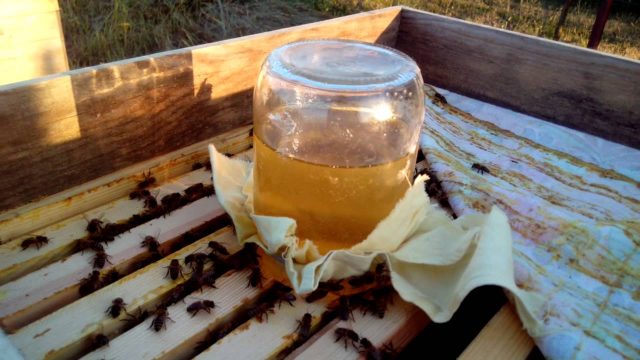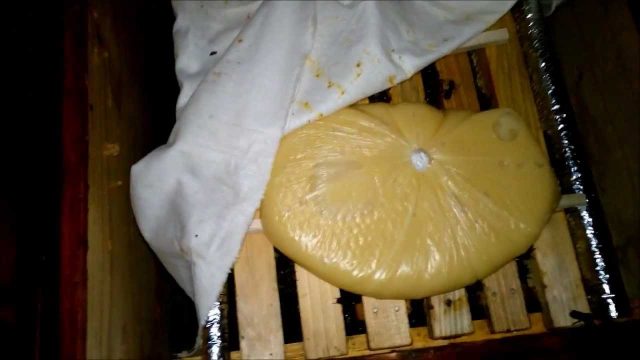Content
The purpose of the autumn feeding is to prepare the bees for the difficult and prolonged winter period. Successful wintering of all members of the bee family is a guarantee of a rich harvest in the new year. It is important to stock up on insect feed on time. Feeding bees in autumn is a whole science that every successful beekeeper should master.
The value of feeding bees in autumn
After the last harvest in late August or early September, bees begin to prepare for wintering. To prevent insects from starving during the cold period, part of the honey is left in the combs.
Feeding insects in autumn, the beekeeper performs the following tasks:
- Providing them with nutrients before spring.
- Carrying out the prevention of diseases by adding drugs to the feed.
- Stimulation of uterine oviposition and growth of the bee colony.
Incentive feeding of bees in autumn during the season with unfavorable weather conditions allows the queen not to suspend the laying of eggs. At the same time, old bees will not die from diseases, and young insects will receive a sufficient supply of protein and vitamins to start working in the spring.
As soon as the first pumping of honey has passed, the bees are fed so as not to stop the honey collection process. The loss of the taken product is replenished, its deficiency does not affect the working capacity of insects.
The beekeeper must annually in the middle of summer create a stock of bee bread and pollen for wintering wards. On average, this is 2 frames of substance per 1 hive.
When to feed bees in autumn
For autumn feeding, beekeepers replace the extra honeycomb in the hive with feeders designed for 3 liters of syrup. Also, for these purposes, glass drinkers in the form of cans, packaging bags, and perforated plastic bottles are used.
Sugar syrup is prepared for complete feeding. Autumn food is more nutritious than spring food. The syrup is prepared in a 1: 2 ratio (water-sugar).
Honey fed is another type of autumn food. It is prepared from 1 kg of honey, diluted in 1 liter of warm boiled water (50 ° C).
After the last honey harvest, they begin to lay food in the hives. The timing of feeding bees in the fall may vary, depending on the region. Basically, the procedure begins in the second half of August, ends in the first half of September, the 10th is the deadline.
Later dressings in the fall are considered unhealthy for insects. Young individuals will die during the processing of the syrup, before they reach spring. In this process, only old insects are involved, which will not survive until the first thaw.
The first time to feed the bees in the fall begins after the final pumping of honey. The procedure begins on August 20. In the southern regions, the process may begin later: in early September, but no later than the 10th. In the second half of September, the event will not allow insects to process all the syrup before the offspring appear.
How much to feed the bees in the fall
To calculate, you need to know the approximate number of bee colonies in the apiary. Syrup or sated is prepared at the rate of 200 g per family per day. Syrup prepared in a ratio of 1: 1.5 (sugar-water) is considered to be of higher quality and suitable for insect feeding in autumn.
For the first procedure in the fall, no more than 1 liter of fresh syrup is poured into the feeders. During the day, they observe how the bee colony processes it. As insects consume sweet complementary foods, the next portion is added. If families eat less sweet food, they remove it and add less fresh food. The syrup must not be allowed to acidify.
To grow brood for winter, 0.5-1 l of honey is enough for one hive every day. The birth of juveniles will be completed by mid-September. Until mid-October, after the cleansing flight, the bees will hibernate.
What to feed the bees in the fall
Sugar feeding is considered the most profitable for the apiary. Honey forage is considered more beneficial for insects, but costly for the farm.
As a top dressing in the fall, the following substances are used in apiaries:
- honey;
- sugar syrup;
- honey fed;
- a mixture of honey and sugar.
Each beekeeper determines the type of feed empirically. Any complementary food has its own advantages and disadvantages.
How to feed honey bees in autumn
For feeding, select 2 frames with honey, print them and put them in the first row in front of everyone else. You can install them around the edges.
If the honey in the comb begins to crystallize, it is softened with a small amount of boiled water, dropping it into the free comb. Once it becomes liquid, it is sent to the hive.
Product deterioration occurs if it is stored for a long time in the hive at temperatures above + 10 ° C. Also, it cannot be boiled and given to insects. This is a poisonous substance for them.
In the absence of a product sealed in a honeycomb in the apiary, collected (centrifugal) honey is used for autumn feeding. Before giving it to bees, it is diluted with water (for 1 kg of product, 1 glass of boiled water). All are connected, poured into an enamel pan, heated in a water bath. As soon as the mass becomes homogeneous, it is poured into feeders and sent to the hive. To save money, use honey with sugar for the autumn feeding of bees.
Feeding bees in the fall with honey fed
Honey, diluted with water in certain proportions, is full. It is prepared in the fall so that the queen bee does not stop laying eggs after rolling. For the autumn feeding of honey-fed bees, take the following proportions: 4 parts of honey and 1 part of warm boiled water. If a product with wax residues is used for complementary foods, it is taken a quarter more than indicated in the recipe. The finished substance is thoroughly filtered. The honey feed is placed in the hive after the honey is completely removed.
How to feed bees in the fall with honey and sugar
Feeding bees in the fall with sugar alone is not beneficial for them. To process sugar, insects spend a lot of energy, after which they die. Honey is well absorbed, it is easier for bees to process it. Therefore, in the fall, 1 or 2 frames with a sweet substance are left in the hive. Additionally, sugar syrup is prepared. Combined feed, which is more gentle for the bee organism.
You can make sugar syrup in proportions of 1: 1 or 1.5: 1 and add up to 5% honey to it. Such autumn feeding of bees with honey is considered more nutritious than syrup.
How to feed bees in autumn with syrup
In autumn, the syrup is prepared in a ratio of 1.5: 1 (sugar-water). This ratio is considered optimal for autumn feeding. First, the water is brought to a boil, then sugar is added and boiled until it is completely dissolved. Once the mixture has cooled, it is poured into the feeders and sent to the hive.
Feeding the bees in the fall with Kandy
This type of food is a viscous substance that resembles plasticine.
It is prepared from crushed sugar and honey. The food is easy to place at the bottom of the hive. Insects start eating it in January, when all other nutrient reserves have run out.
For the Kandy mixture, the ingredients are taken in the following proportions:
- honey - 250 ml;
- powdered sugar - 0.75 kg;
- boiled water - 100 ml;
- vinegar - 0.5 tsp
For a mixture of a sweet product, take an unacidified, fresh one. Powdered sugar should not contain starch.
The crushed sugar is mixed with honey, the rest of the ingredients are added. The mixture will resemble dough, it is kneaded until it becomes homogeneous and stops spreading.
Thin cakes weighing 1 kg are made from the finished fondant and put into the hive. You can place food above the frames or at the bottom of the hive.
Autumn feeding of bees with infusions and decoctions
To heal honey insects and support them in winter, decoctions and herbal infusions are used. They are combined with all types of feed.
To combat ticks, use a tincture of red pepper. To prepare it, take a dried pod and grind it. For 1 liter of boiling water, you need to take 55 g of chopped pepper. Next, the ingredients are combined and insisted for at least 12 hours. After the infusion is combined with sugar syrup, prepared in proportions 1: 1. Top dressing and pepper infusion are mixed in a ratio of 1:10, respectively. The mixture is added to the feeders and placed in the hive. Insects are fed this way 3 times a month with an interval of 10 days.
Effective infusion against nosematosis: 20 g of dried herb St. John's wort, 10 g of calendula, 20 g of mint. Combine herbs, pour a liter of boiling water, cook for 15 minutes in a water bath. As soon as the broth has cooled, it is filtered, combined with the syrup.
Sweet dressing, prepared in a 1: 1 ratio, take 1 liter, herbal infusion - 50 ml. The liquids are combined, mixed thoroughly and added to the feeders in the hives. Insects are treated this way every other day for a month.
How to feed bees in the fall
For feed, use ceiling feeders, with a maximum capacity of 3 liters, they are also suitable for 1 liter. The syrup can be poured into empty honeycombs or plastic bottles with holes.
In the fall, insects are fed at the rate of 200 g of fed or syrup per 1 bee colony per day. Depending on the number of inhabitants of the hive, the daily feed rate and the number of feeders that can be placed are calculated.
Top dressing in the fall is carried out in the evening once a day, when the insects stop flying. Food left overnight should be eaten by morning. If this does not happen, the next day they give a smaller rate.
Observing the apiary after feeding
After feeding in the fall, an audit of bee colonies is carried out. Unproductive insects are discarded, those born in August are left in their mothers. In September, all honey has already been pumped out, so stronger bee colonies can take food from the weaker ones. This must be monitored. If an insect tries to get into the entrance not directly, but as if from the side, it is a stranger, it must be driven away. Otherwise, weak bee colonies will be left without food for the winter.
Conclusion
Feeding bees in the fall is an important procedure that is carried out after the last pitching. It helps to support weak insects, to bring out new offspring before winter. Stimulating feeding of bees in the fall is important for increasing the population of the hive.












